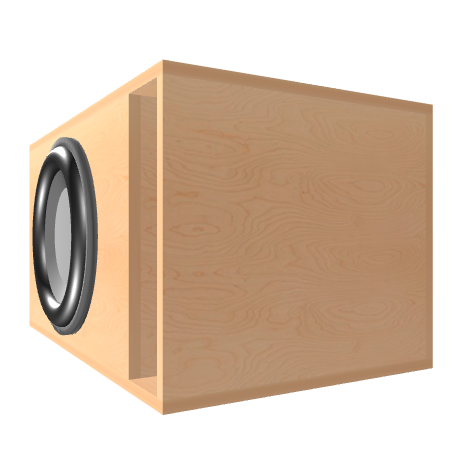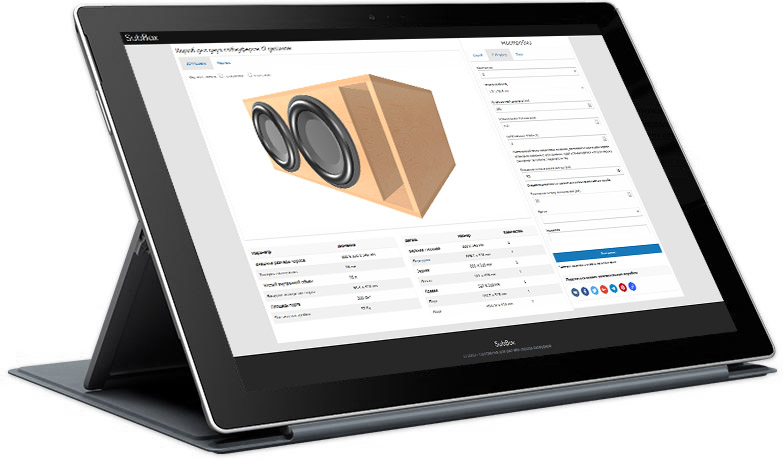Subwoofer Box Calculator Software. AJ Sealed Designer v.2.0. AJ Sealed Designer - solving the required calculations for custom sealed box cabinet designs. Can be used for car, truck, sport utility vehicle (SUV), jeep automotive, guitar and home theater applications and projects. AJ Sealed Designer provides a. Information about the End Correction Factor (k) In acoustics, end correction is a short distance applied or added to the actual length of a resonance pipe, in order to calculate the precise resonant frequency of the pipe. WinISD is a great speaker design software that is designed for the Windows platform. Adobe reader 10.9.5. The software is 100% free and offers quite a wide range of features. With this, it is easy and possible for the users to create vented, bandpass as well as closed boxes that will deliver quality sounds.
The WinISD Pro application was designed to be a freeware speaker designer software. You will be able to design Closed, Vented, Bandpass boxes and passive radiators with this program. It also allows you to calculate few different types of filters.
Is freeware speaker designing software for Windows 9x/NT environment. You can design Closed, Vented and Bandpass boxes with this program. It also allows you to calculate few different types of filters.
WinISD Pro a free speaker designer software that also allows you to calculate few different types of filters.

What’s new in WinISD Pro 0.50 Alpha 7:
Install omnisphere 2 in logic pro x. Get help for the Speaker Volume Calculator Use the Speaker Box Designer to determine the correct Speaker Box Volume for Your Driver Use the Driver Displacement. THE NUMBER ONE SOURCE FOR ALL YOUR CAR AUDIO NEEDS! Sky High Car Audio, SecondSkinAudio Sound Deadener, MECHMAN, SKAR AUDIO, SUNDOWN AUDIO, XS POWER and SMD Products.
Sealed Subwoofer Box Calculator

Subwoofer Box Design Calculator
New:
· If project file is changed, program now asks if user wants to save the project. (Juha)
· Added voice coil thermal simulation fields. Now you can simulate effect of voice coil heating based on temperature rise that you specify. You can also specify resistance temperature coefficient of voice coil material. (Janne)
· Added several alignment options for closed and vented box. Program now suggests different alignments based on Qts value. (Janne)
· Box alignment calculation now considers external resistance and reduction of Q as box has some absorption loss. Leak losses are not considered when calculating alignments. (Janne)
· Added passive radiator extra mass dragging for passive radiator. Dragging vertically changes passive radiator extra mass => tuning frequency is changed. This requires that you enter some initial extra mass for passive
· radiator for this to work. (Janne)
· Added showing of air density value to “Environment tab”. (Janne)
· Added option to “cross-calculate” vents. User can now specify physical vent properties, and tuning frequency is calculated according that length. This can help when studying existing boxes. No more guesswork. (Janne)
· When changing environment values, physical vent dimensions stay constant, and box tuning is recalculated. This allows you to investigate temperature sensitivity of your design. (Janne)
· Added calculation of first port resonance frequency. This shows frequency of first “organ pipe” resonance. Others are multiplies of this frequency. (Janne)
· Added option to change end correction factor. (Janne)
· Added drawing of -3 dB line. (Janne)
· Added drawing of excursion limit. (Janne)
· Added option to configure rms, peak or peak-to-peak excursion and air velocities. (Janne)
· Added calculation of off-axis responses. User can now specify off-axis angle. (Janne)
· Added simulation of various types of prototype filters. This is very nice feature, since now you can add various combinations of these filters, and see their combined impact on frequency response (magnitude and phase), cone excursion and group delay. You can also plot frequency response or group delay of equalizer/filter chain.
· EQ/Filter transfer function magnitude plot has its own plot limits. (Janne, Juha)
· Added option relative cursor readings. Just doubleclick in plot window after setting to reference point to enable relative cursor readings. (Janne)
· Added option to change and specify voice coil connection mode, all VCs in parallel or in series. (Janne)
· Added amplifier apparent power graph. This shows apparent power taken from the feeding amplifier, to assess amplifier loading. (Janne)
· Added parameter tracking to the driver editor. Now driver editor tracks which parameters were entered and which were calculated. (Janne)
· Driver editor now internally recalculates all calculated parameters, when user enters new value for already entered parameter. This makes easy to correct entries. (Janne)
· Driver editor now checks all parameters by calculating through all relations between parameters. This assures that data is always
· correct. (Janne)
Changes:
· Moved “check internet for new version” under “Help/online” menu (Juha)
· Changed online support to point forums instead of email (Juha)
· Changed text “Frc” to “Fsc” for more consistency, like Qts => Qtc. (Janne)
· Calculation of models rewritten for better clarity. (Janne)
Bugs fixed:
· ‘New project’-window now remembers last driver (Juha)
· Many cosmetic fixes. (Juha)
· Fixed toolbar colours if user was using customized colour scheme. (Juha)
· Fixed bug where certain editboxes were hard to edit by hand (program was overwriting what you just typed) (Juha)

JLCPCB – Prototype 10 PCBs for $2 (For Any Color)
China’s Largest PCB Prototype Enterprise, 600.000+ Customers & 10.000+ Online Orders Daily
See Why JLCPCB Is So Popular: https://jlcpcb.com